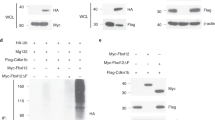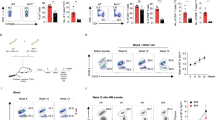Abstract
Notch signals are necessary for the functional outcomes of T cell receptor β-selection, including differentiation, proliferation and rescue from apoptosis. The mechanism underlying this requirement for T cell development is unknown. Here we show that Notch receptor and Delta-like 1 ligand interactions promoted the survival of CD4−CD8− pre–T cells through the maintenance of cell size, glucose uptake and metabolism. Furthermore, the trophic effects of Notch signaling were mediated by the pathway of phosphatidylinositol-3-OH kinase and the kinase Akt, such that expression of active Atk overcame the requirement for Notch in β-selection. Collectively, our results demonstrate involvement of Notch receptor–ligand interactions in the regulation of cellular metabolism, thus enabling the autonomous signaling capacity of the pre–T cell receptor complex.
*Note: In the version of this article initially published online, in the fourth sentence of the abstract, the term "Atk" was a misspelling; this should be "Akt." In the fourth sentence of the second paragraph of the introduction, the name of the second kinase mentioned, "PI(3)K-dependent kinase 1," was incorrect; this should read "phosphoinositide-dependent kinase 1." These errors have been corrected for the HTML and print versions of the article.
This is a preview of subscription content, access via your institution
Access options
Subscribe to this journal
Receive 12 print issues and online access
$209.00 per year
only $17.42 per issue
Buy this article
- Purchase on Springer Link
- Instant access to full article PDF
Prices may be subject to local taxes which are calculated during checkout







Similar content being viewed by others
Change history
14 August 2005
appended aop PDF with corrigendum (will be corrected for print issue), and placed footnote in XML at abstract
References
Godfrey, D.I., Kennedy, J., Suda, T. & Zlotnik, A. A developmental pathway involving four phenotypically and functionally distinct subsets of CD3−CD4−CD8−- triple-negative adult mouse thymocytes defined by CD44 and CD25 expression. J. Immunol. 150, 4244–4252 (1993).
Livak, F., Tourigny, M., Schatz, D.G. & Petrie, H.T. Characterization of TCR gene rearrangements during adult murine T cell development. J. Immunol. 162, 2575–2580 (1999).
Michie, A.M. & Zúñiga-Pflücker, J.C. Regulation of thymocyte differentiation: pre-TCR signals and β-selection. Semin. Immunol. 14, 311–323 (2002).
Schmitt, T.M. & Zuniga-Pflucker, J.C. Thymus-derived signals regulate early T-cell development. Crit. Rev. Immunol. 25, 141–160 (2005).
Nicholson, K.M. & Anderson, N.G. The protein kinase B/Akt signalling pathway in human malignancy. Cell. Signal. 14, 381–395 (2002).
Gottlob, K. et al. Inhibition of early apoptotic events by Akt/PKB is dependent on the first committed step of glycolysis and mitochondrial hexokinase. Genes Dev. 15, 1406–1418 (2001).
Plas, D.R., Talapatra, S., Edinger, A.L., Rathmell, J.C. & Thompson, C.B. Akt and Bcl-xL promote growth factor-independent survival through distinct effects on mitochondrial physiology. J. Biol. Chem. 276, 12041–12048 (2001).
Rathmell, J.C. et al. Akt-directed glucose metabolism can prevent Bax conformation change and promote growth factor-independent survival. Mol. Cell. Biol. 23, 7315–7328 (2003).
Schmitt, T.M., Ciofani, M., Petrie, H.T. & Zúñiga-Pflücker, J.C. Maintenance of T cell specification and differentiation requires recurrent notch receptor-ligand interactions. J. Exp. Med. 200, 469–479 (2004).
Radtke, F., Wilson, A., Mancini, S.J. & MacDonald, H.R. Notch regulation of lymphocyte development and function. Nat. Immunol. 5, 247–253 (2004).
Maillard, I., Fang, T. & Pear, W.S. Regulation of lymphoid development, differentiation, and function by the Notch pathway. Annu. Rev. Immunol. 23, 945–974 (2005).
Wolfer, A., Wilson, A., Nemir, M., MacDonald, H.R. & Radtke, F. Inactivation of Notch1 impairs VDJβ rearrangement and allows pre-TCR-independent survival of early αβ lineage thymocytes. Immunity 16, 869–879 (2002).
Ciofani, M. et al. Obligatory role for cooperative signaling by pre-TCR and Notch during thymocyte differentiation. J. Immunol. 172, 5230–5239 (2004).
Schmitt, T.M. & Zúñiga-Pflücker, J.C. Induction of T cell development from hematopoietic progenitor cells by delta-like-1 in vitro. Immunity 17, 749–756 (2002).
Zúñiga-Pflücker, J.C. T-cell development made simple. Nat. Rev. Immunol. 4, 67–72 (2004).
Shinkai, Y. et al. RAG-2-deficient mice lack mature lymphocytes owing to inability to initiate V(D)J rearrangement. Cell 68, 855–867 (1992).
Shinkai, Y. et al. Restoration of T cell development in RAG-2-deficient mice by functional TCR transgenes. Science 259, 822–825 (1993).
Deftos, M.L., He, Y.W., Ojala, E.W. & Bevan, M.J. Correlating notch signaling with thymocyte maturation. Immunity 9, 777–786 (1998).
Jehn, B.M., Bielke, W., Pear, W.S. & Osborne, B.A. Cutting edge: protective effects of notch-1 on TCR-induced apoptosis. J. Immunol. 162, 635–638 (1999).
Sade, H., Krishna, S. & Sarin, A. The anti-apoptotic effect of Notch-1 requires p56lck-dependent, Akt/PKB-mediated signaling in T cells. J. Biol. Chem. 279, 2937–2944 (2004).
Penit, C., Lucas, B. & Vasseur, F. Cell expansion and growth arrest phases during the transition from precursor (CD4−8−) to immature (CD4+8+) thymocytes in normal and genetically modified mice. J. Immunol. 154, 5103–5113 (1995).
Green, D.R. & Kroemer, G. The pathophysiology of mitochondrial cell death. Science 305, 626–629 (2004).
Belloc, F. et al. Flow cytometry detection of caspase 3 activation in preapoptotic leukemic cells. Cytometry 40, 151–160 (2000).
Bellavia, D. et al. Constitutive activation of NF-κB and T-cell leukemia/lymphoma in Notch3 transgenic mice. EMBO J. 19, 3337–3348 (2000).
Vander Heiden, M.G. et al. Growth factors can influence cell growth and survival through effects on glucose metabolism. Mol. Cell. Biol. 21, 5899–5912 (2001).
Rathmell, J.C., Vander Heiden, M.G., Harris, M.H., Frauwirth, K.A. & Thompson, C.B. In the absence of extrinsic signals, nutrient utilization by lymphocytes is insufficient to maintain either cell size or viability. Mol. Cell 6, 683–692 (2000).
Downward, J. Mechanisms and consequences of activation of protein kinase B/Akt. Curr. Opin. Cell Biol. 10, 262–267 (1998).
Pallard, C. et al. Distinct roles of the phosphatidylinositol 3-kinase and STAT5 pathways in IL-7-mediated development of human thymocyte precursors. Immunity 10, 525–535 (1999).
von Freeden-Jeffry, U., Solvason, N., Howard, M. & Murray, R. The earliest T lineage-committed cells depend on IL-7 for Bcl-2 expression and normal cell cycle progression. Immunity 7, 147–154 (1997).
Hagenbeek, T.J. et al. The loss of PTEN allows TCR αβ lineage thymocytes to bypass IL-7 and pre-TCR-mediated signaling. J. Exp. Med. 200, 883–894 (2004).
Newton, K., Harris, A.W. & Strasser, A. FADD/MORT1 regulates the pre-TCR checkpoint and can function as a tumour suppressor. EMBO J. 19, 931–941 (2000).
Jiang, D., Lenardo, M.J. & Zúñiga-Pflücker, J.C. p53 prevents maturation to the CD4+CD8+ stage of thymocyte differentiation in the absence of T cell receptor rearrangement. J. Exp. Med. 183, 1923–1928 (1996).
Rathmell, J.C., Farkash, E.A., Gao, W. & Thompson, C.B. IL-7 enhances the survival and maintains the size of naive T cells. J. Immunol. 167, 6869–6876 (2001).
Whetton, A.D., Bazill, G.W. & Dexter, T.M. Haemopoietic cell growth factor mediates cell survival via its action on glucose transport. EMBO J. 3, 409–413 (1984).
Edinger, A.L. & Thompson, C.B. Akt maintains cell size and survival by increasing mTOR-dependent nutrient uptake. Mol. Biol. Cell 13, 2276–2288 (2002).
Eagar, T.N. et al. Notch 1 signaling regulates peripheral T cell activation. Immunity 20, 407–415 (2004).
Kim, K., Lee, C.K., Sayers, T.J., Muegge, K. & Durum, S.K. The trophic action of IL-7 on pro-T cells: inhibition of apoptosis of pro-T1, -T2, and -T3 cells correlates with Bcl-2 and Bax levels and is independent of Fas and p53 pathways. J. Immunol. 160, 5735–5741 (1998).
Yu, Q., Erman, B., Bhandoola, A., Sharrow, S.O. & Singer, A. In vitro evidence that cytokine receptor signals are required for differentiation of double positive thymocytes into functionally mature CD8+ T cells. J. Exp. Med. 197, 475–487 (2003).
Frauwirth, K.A. et al. The CD28 signaling pathway regulates glucose metabolism. Immunity 16, 769–777 (2002).
Nie, L., Xu, M., Vladimirova, A. & Sun, X.H. Notch-induced E2A ubiquitination and degradation are controlled by MAP kinase activities. EMBO J. 22, 5780–5792 (2003).
Talora, C. et al. Pre-TCR-triggered ERK signalling-dependent downregulation of E2A activity in Notch3-induced T-cell lymphoma. EMBO Rep. 4, 1067–1072 (2003).
Engel, I. & Murre, C. E2A proteins enforce a proliferation checkpoint in developing thymocytes. EMBO J. 23, 202–211 (2004).
Sicinska, E. et al. Requirement for cyclin D3 in lymphocyte development and T cell leukemias. Cancer Cell 4, 451–461 (2003).
Zweidler-McKay, P.A. & Pear, W.S. Notch and T cell malignancy. Semin. Cancer Biol. 14, 329–340 (2004).
Malstrom, S., Tili, E., Kappes, D., Ceci, J.D. & Tsichlis, P.N. Tumor induction by an Lck-MyrAkt transgene is delayed by mechanisms controlling the size of the thymus. Proc. Natl. Acad. Sci. USA 98, 14967–14972 (2001).
Bellavia, D. et al. Combined expression of pTα and Notch3 in T cell leukemia identifies the requirement of preTCR for leukemogenesis. Proc. Natl. Acad. Sci. USA 99, 3788–3793 (2002).
Allman, D. et al. Separation of Notch1 promoted lineage commitment and expansion/transformation in developing T cells. J. Exp. Med. 194, 99–106 (2001).
Ashcroft, S.J., Weerasinghe, L.C., Bassett, J.M. & Randle, P.J. The pentose cycle and insulin release in mouse pancreatic islets. Biochem. J. 126, 525–532 (1972).
Acknowledgements
We thank D.A. Vignali for the MIY retroviral vector; J. Maryanski for the MIG-TCRβ construct; W. Pear for the MigR retroviral vector; and G. Knowles for assistance in cell sorting. Supported by the Canadian Institutes of Health Research (Doctoral Research Award to M.C., and grant MOP 42387) and a Canada Research Chair in Developmental Immunology (J.C.Z.-P.).
Author information
Authors and Affiliations
Corresponding author
Ethics declarations
Competing interests
The authors declare no competing financial interests.
Supplementary information
Supplementary Fig. 1
The majority of Rag2−/− DN3 cells in OP9-DL1 and OP9-control cultures are non-cycling. (PDF 3241 kb)
Supplementary Fig. 2
Bcl-2 expression partially rescues the decline in cellularity following withdrawal of Notch-Delta-like-1 interaction. (PDF 1094 kb)
Supplementary Fig. 3
PI3K signals are indispensable for Notch-mediated trophic effects. (PDF 2995 kb)
Supplementary Table 1
Gene-specific primers used in RT-PCR analysis. (PDF 45 kb)
Rights and permissions
About this article
Cite this article
Ciofani, M., Zúñiga-Pflücker, J. Notch promotes survival of pre–T cells at the β-selection checkpoint by regulating cellular metabolism. Nat Immunol 6, 881–888 (2005). https://doi.org/10.1038/ni1234
Received:
Accepted:
Published:
Issue Date:
DOI: https://doi.org/10.1038/ni1234
This article is cited by
-
Neurofibromin 1 controls metabolic balance and Notch-dependent quiescence of murine juvenile myogenic progenitors
Nature Communications (2024)
-
Hydrogel-based microenvironment engineering of haematopoietic stem cells
Cellular and Molecular Life Sciences (2023)
-
A double-negative thymocyte-specific enhancer augments Notch1 signaling to direct early T cell progenitor expansion, lineage restriction and β-selection
Nature Immunology (2022)
-
Deletion of the mitochondria-shaping protein Opa1 during early thymocyte maturation impacts mature memory T cell metabolism
Cell Death & Differentiation (2021)
-
O-GlcNAcylation and its role in the immune system
Journal of Biomedical Science (2020)



